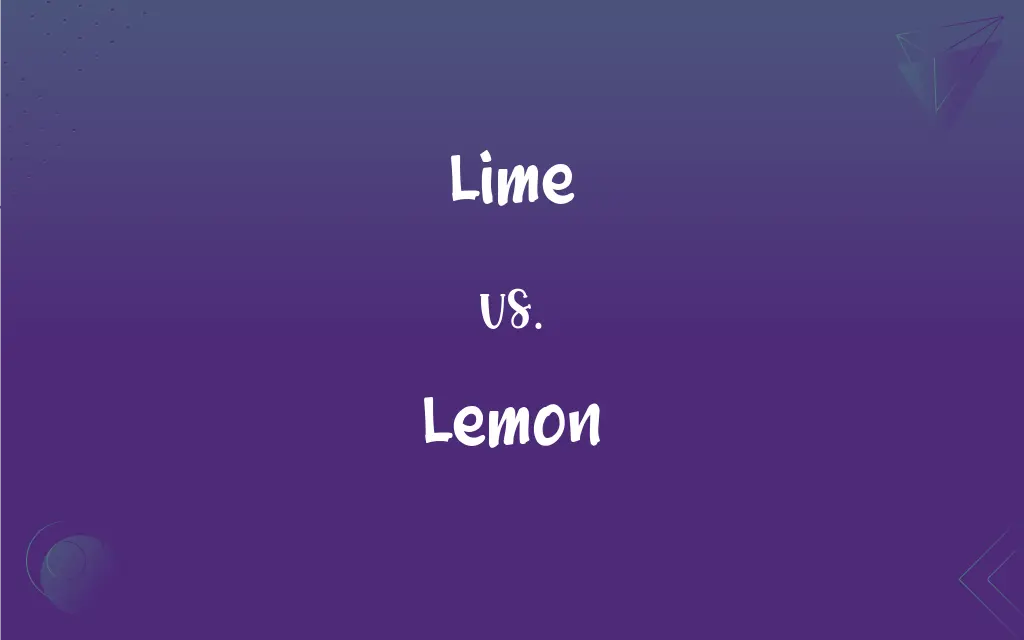Lime vs. Lemon: What's the Difference?
Edited by Aimie Carlson || By Harlon Moss || Updated on October 6, 2023
Lime and lemon are both citrus fruits but differ in size, color, and flavor; limes are typically smaller, green, and have a sweeter or more bitter taste, while lemons are larger, yellow, and have a bright, slightly sweet flavor.

Key Differences
Limes and lemons share a place in the same citrus fruit family but have distinctive physical characteristics. Limes are typically smaller and can be either green or yellow when ripe. Lemons, conversely, are larger and primarily recognized for their bright yellow hue. Both can enhance the flavor of foods and drinks but have different impacts due to their varied tastes and acidity levels.
From a culinary perspective, lime and lemon are also employed distinctly in various cuisines. Lime, especially the key lime variety, is often utilized in Thai and Mexican cuisines, providing a sweet yet sometimes bitter flavor. In contrast, lemons are widely used in both savory and sweet dishes in various cuisines, offering a reliably zesty and slightly sweet flavor.
Lime and lemon trees exhibit differences in their size and foliage as well. Lime trees tend to be smaller and possess denser foliage, while lemon trees are generally larger with somewhat sparse, dark green leaves. Both contribute significantly to culinary practices worldwide, though they're each celebrated for distinct characteristics and uses.
When it comes to nutritional content, both lime and lemon are low in calories and rich in vitamin C, though they possess varied levels of other vitamins and minerals. Lemons generally contain slightly more vitamin C than limes. Both are utilized not only as a food source but also in medicinal and health-oriented applications due to their nutritional benefits.
From a cultural and symbolic viewpoint, limes and lemons have established their own unique identities. For instance, lemons are often associated with freshness, cleanliness, and even are used metaphorically to indicate something that is unwanted or defective ("When life gives you lemons..."). Lime, particularly in the form of a lime wedge, is commonly affiliated with tropical beverages and a fresh, zesty aesthetic in culinary presentations.
ADVERTISEMENT
Comparison Chart
Color
Green (commonly), or yellow
Primarily yellow
Size
Typically smaller
Larger
Flavor
Sweeter or more bitter
Bright and slightly sweet
Culinary Use
Prevalent in Thai & Mexican
Versatile in various cuisines
Tree Size
Smaller tree, dense foliage
Larger tree, sparser foliage
ADVERTISEMENT
Lime and Lemon Definitions
Lime
Lime is a green, typically small, round fruit with acidic juice.
The bartender added a twist of lime to the cocktail for an extra zing.
Lemon
A tree that produces the lemon fruit.
The lemon tree in my backyard is finally bearing fruit.
Lime
Lime refers to the small citrus fruit, often used in cooking and baking.
The recipe calls for the zest of one lime to enhance the flavor.
Lemon
A bright yellow citrus fruit with a sour taste.
She squeezed the lemon to add some juice to her tea.
Lime
Lime, in a botanical sense, refers to a tropical and subtropical citrus tree, scientifically known as Citrus aurantiifolia.
Lime trees in the backyard yield fresh fruit that can be used in various dishes.
Lemon
A defective product or thing regarded as unsatisfactory or unacceptable.
I bought a car that turned out to be a lemon; it broke down after just a week.
Lime
Lime can also indicate a type of white powder derived from limestone, used in building.
The mason added lime to the mixture to create a sturdy mortar for the bricks.
Lemon
A pale yellow color.
She painted her room a soft lemon shade.
Lime
Lime is a shade of color, a pale, greenish-yellow.
She chose a bright lime color for her summer dress to reflect the vibrant season.
Lemon
A person or thing that proves to be defective, imperfect, or unsatisfactory.
That quarterback was a real lemon during last night's game.
Lime
Any of several evergreen trees or shrubs of the genus Citrus having edible green or greenish-yellow fruit, especially the Mexican lime and the Persian lime.
Lemon
A spiny evergreen tree (Citrus limon) native to Asia, widely cultivated for its oval yellow fruit.
Lime
The fruit of any of these plants, having a pulpy interior and usually acid juice.
Lemon
The fruit of this tree, having an aromatic rind and juicy, acid pulp.
Lime
See linden.
Lemon
Lemon yellow.
FAQs
How does the taste of lime compare to lemon?
Limes are often more tart and have a more intense sourness than lemons.
Are there any potential health benefits of consuming lemons and limes?
Both fruits are rich in vitamin C and other antioxidants which can support immune function and overall health.
What about varieties of limes?
Some common varieties are Persian (or Tahiti), Key lime, and Kaffir lime.
Can I grow lemon and lime trees indoors?
Yes, with proper care, light, and conditions, both lemon and lime trees can be grown as indoor plants.
What is a lime?
A lime is a green, typically round, citrus fruit that is smaller than a lemon.
Are lime leaves edible?
Yes, Kaffir lime leaves are often used in Southeast Asian cuisine for their aromatic flavor.
Can I zest a lime as well?
Yes, lime zest can be used similarly to lemon zest in recipes for a distinct flavor.
How can I store lemons and limes?
Both can be stored at room temperature for a week or in the refrigerator for longer shelf life.
Why is my lemon tree flowering but not producing fruit?
This can be due to various reasons including poor pollination, unfavorable weather conditions, or nutrient imbalances.
Is lime water the same as water with lime juice?
No, lime water often refers to a solution of calcium hydroxide in water, while water with lime juice is simply water with the juice of a lime added.
Which is more acidic, lime or lemon?
Both are acidic, but limes are generally considered to be slightly more acidic than lemons.
What is the main difference between lime and lemon trees?
Lime trees are generally smaller than lemon trees and have smaller, darker green leaves.
Do limes have vitamin C as well?
Yes, limes also provide a good amount of vitamin C.
Why do some recipes call for lemon zest?
Lemon zest provides a burst of lemon flavor without the added liquid of the juice.
What are some common varieties of lemons?
Some common varieties include Eureka, Lisbon, and Meyer lemons.
Can I use limes and lemons on my skin?
Citrus juice can be used for some skin treatments, but be cautious as it can cause sensitivity to sunlight.
Can I use lime juice as a substitute for lemon juice?
While both are citrusy and acidic, they have distinct flavors. In some recipes, they can be interchangeable, but the end result might have a slightly different taste.
Are lemons a good source of vitamin C?
Yes, lemons are an excellent source of vitamin C.
How do I juice a lemon or lime without a juicer?
You can roll the fruit on a hard surface with slight pressure, then cut and squeeze by hand.
What's the best way to get more juice from my lemon or lime?
Microwaving the fruit for 10-20 seconds or rolling it firmly on a countertop can help release more juice.
About Author
Written by
Harlon MossHarlon is a seasoned quality moderator and accomplished content writer for Difference Wiki. An alumnus of the prestigious University of California, he earned his degree in Computer Science. Leveraging his academic background, Harlon brings a meticulous and informed perspective to his work, ensuring content accuracy and excellence.
Edited by
Aimie CarlsonAimie Carlson, holding a master's degree in English literature, is a fervent English language enthusiast. She lends her writing talents to Difference Wiki, a prominent website that specializes in comparisons, offering readers insightful analyses that both captivate and inform.































































